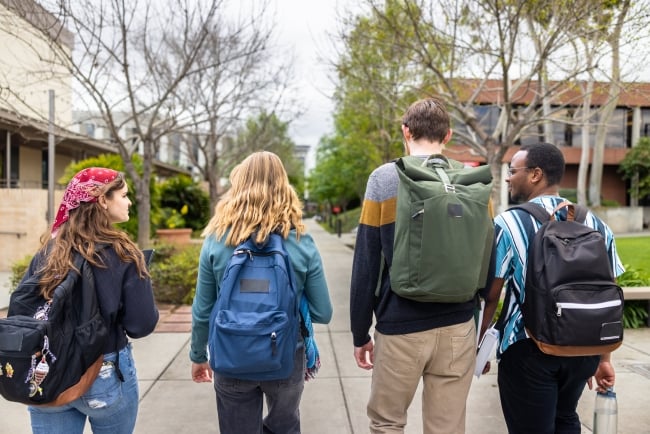You have /5 articles left.
Sign up for a free account or log in.

FAFSA data can be used to connect low-income learners with eligibility information for federal benefits like food assistance.
adamkas/E+/Getty Images
Basic needs insecurity continues to impact college students’ success, retention and completion in higher education, but few institutions are using their already-existing data to connect learners with federal benefits.
In 2022, the Department of Education sent a Dear Colleague letter to colleges and universities encouraging them to pull student data from the Free Application for Federal Student Aid to directly communicate with students who are eligible for means-tested benefits: Supplemental Nutrition Assistance Program (SNAP), Medicaid and the Child Tax Credit, among others.
A new survey from Higher Learning Advocates and the National Association of Student Financial Aid Administrators sought to gauge how many institutions undertook this work and some of the opportunities to improve direct outreach to at-need students. The survey was conducted in March 2023 and released last month.
FAFSA Rollout 2024
Colleges and universities will not receive FAFSA data until March this year, due to delays with the rollout of the revised financial aid application. The Department of Education has promised $50 million to support financial aid officers in creating aid packages, with a focus on minority-serving institutions.
Methodology
Higher Learning Advocates partnered with NASFAA to survey financial aid officers and determine if and how they’re using FAFSA data to alert students for their eligibility for different programs.
The survey was distributed March 6, 2023, to 2,638 contacts at member institutions. The survey had a 13.6 percent response rate, with 275 completed surveys and 84 with at least one response.
Survey results: The largest share of institutions said they do not use FAFSA data to alert students of their eligibility for benefits (61 percent), and of those, 43 percent said they had no plans to do so. Fewer than three in 10 (27 percent) provided direct outreach, and 12 percent were unsure.
Among institutions that conducted outreach, this was done primarily through the financial aid office (46 percent) or in partnership with another office (34 percent).
Most institutions communicating about this provided information on SNAP (85 percent) or the Affordable Connectivity Program (64 percent), which provides aid paying for internet service. A similar, but smaller, set of institutions provided direct outreach without FAFSA data for SNAP (77 percent) and the Affordable Connectivity Program (57 percent).
Setbacks: The primary reason institutions reported not engaging in direct outreach was resource constraints, with 72 percent of respondents indicating this was a barrier. Second was concerns about having to answer follow-up questions that the office does not have the expertise to answer (43 percent), followed by fear of using FAFSA data in ways that are not authorized by the government (23 percent) or the student (23 percent).
While the Department of Education’s letter emphasizes the importance of correctly using FAFSA data, it does permit colleges and universities to do this work, according to the report.
During the 2024–25 aid year, income information on the FAFSA will come directly from the IRS, which means there are stricter data-sharing limitations, according to the report. As a result, financial aid administrators cannot share those data with basic needs staff or external social service organizations.
Ways to support students: For higher education professionals looking to better assist students with basic needs insecurity, the report offers five ways to increase access to supports.
- Share information with students. Communication shared by mail, email or text can provide students with information on eligibility and the availability of means-tested benefits programs, including relevant county or state social services agencies. Sierra College in California, for example, sends an autogenerated email to students who may be eligible for ACP and CalFresh, California’s food-assistance program.
- Work with a basic needs center or benefits navigator. To reduce the workload of financial aid officers, other campus stakeholders can serve as partners. At the Community College of Allegheny County in Pennsylvania, the dean of students’ office partners with financial aid to search FAFSA data, looking for eligible students. They then share the information with resource navigators, who conduct outreach and encourage students to connect to resources. Staff at the University of California, Santa Barbara, partner with students working at the on-campus food pantry and basic needs center to provide peer support.
- Provide documentation for students’ benefits application. Students require different documents to prove eligibility for benefits, such as proof of Pell receipt or eligibility for work-study, which the financial aid office can supply.
- Help students apply for benefits. Staff can come alongside students to help them complete the benefits application. The financial aid office at Cuyahoga Community College in Ohio provides help to students who do not utilize benefits already, providing individualized outreach and peer workers who can help students apply online.
- Coordinate with local organizations to expand access to benefits. Institutions can work alongside social and human services agencies to help students utilize services. One partnership is between the University of California, Berkeley, and the Alameda County Department of Social Services, which meet regularly to talk about policy and outreach efforts.
Do you have a wellness tip that might help others encourage student success? Tell us about it.




